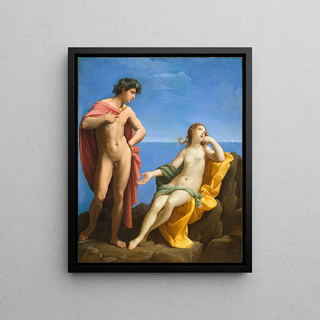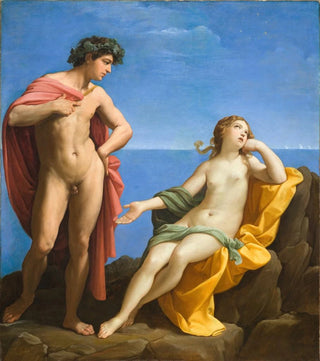Art print | Bacchus and Ariadne - Guido Reni


View from behind

Frame (optional)
Art print Bacchus et Ariane - Guido Reni – Engaging Introduction
The artwork "Bacchus et Ariane" by Guido Reni is an invitation to immerse oneself in a world where mythology and art meet with rare elegance. This canvas, filled with emotion and symbolism, depicts a pivotal moment in Ariane's legend, who, after helping Theseus defeat the Minotaur, is abandoned on the island of Naxos. It is there that Bacchus, the god of wine and celebration, discovers her and offers her a new life full of passion and exuberance. The scene depicted by Reni is both dramatic and romantic, capturing the very essence of divine love and rebirth. Through this art print, the viewer is transported into a universe where the sublime and the profane intertwine, revealing the power of art to evoke timeless stories.
Style and uniqueness of the work
Guido Reni's style is characterized by an exceptional mastery of light and shadow, as well as a delicate color palette that gives his characters a timeless beauty. In "Bacchus et Ariane," the artist uses warm and golden tones to create an atmosphere of festivity and celebration. The faces of the protagonists, imbued with poignant expressiveness, demonstrate a sensitivity that touches the heart. The dynamic composition, with Bacchus advancing towards Ariane, evokes a fluid movement that draws the eye and guides the viewer through the scene. Reni manages to capture the precise moment when the budding love between the two characters seems to transcend time, creating an emotional connection with the viewer. This work is thus a perfect example of baroque, where movement, light, and color combine to create an unforgettable visual experience.
The artist and his influence
Guido Reni, born in Bologna in 1575, is one of the masters of Italian baroque. His career, marked by diverse influences ranging from the Renaissance to Antiquity, allows him to develop a unique style that combines grandeur and delicacy. Reni has established himself as one of the most renowned painters

Matte finish

View from behind

Frame (optional)
Art print Bacchus et Ariane - Guido Reni – Engaging Introduction
The artwork "Bacchus et Ariane" by Guido Reni is an invitation to immerse oneself in a world where mythology and art meet with rare elegance. This canvas, filled with emotion and symbolism, depicts a pivotal moment in Ariane's legend, who, after helping Theseus defeat the Minotaur, is abandoned on the island of Naxos. It is there that Bacchus, the god of wine and celebration, discovers her and offers her a new life full of passion and exuberance. The scene depicted by Reni is both dramatic and romantic, capturing the very essence of divine love and rebirth. Through this art print, the viewer is transported into a universe where the sublime and the profane intertwine, revealing the power of art to evoke timeless stories.
Style and uniqueness of the work
Guido Reni's style is characterized by an exceptional mastery of light and shadow, as well as a delicate color palette that gives his characters a timeless beauty. In "Bacchus et Ariane," the artist uses warm and golden tones to create an atmosphere of festivity and celebration. The faces of the protagonists, imbued with poignant expressiveness, demonstrate a sensitivity that touches the heart. The dynamic composition, with Bacchus advancing towards Ariane, evokes a fluid movement that draws the eye and guides the viewer through the scene. Reni manages to capture the precise moment when the budding love between the two characters seems to transcend time, creating an emotional connection with the viewer. This work is thus a perfect example of baroque, where movement, light, and color combine to create an unforgettable visual experience.
The artist and his influence
Guido Reni, born in Bologna in 1575, is one of the masters of Italian baroque. His career, marked by diverse influences ranging from the Renaissance to Antiquity, allows him to develop a unique style that combines grandeur and delicacy. Reni has established himself as one of the most renowned painters






